Prevalence of Dengue Virus Serotypes
VerifiedAdded on 2021/04/16
|9
|2004
|182
AI Summary
The provided research identifies the prevalence of dengue virus serotypes in Saudi Arabia, specifically noting the emergence of serotype 4. The study emphasizes the need for blood screening in areas where dengue is prevalent, including regions with high numbers of Indian and Pakistani workers who may be asymptomatic carriers of the disease. This information has significant implications for public health policies and practices related to blood donation and transfusion safety.
Contribute Materials
Your contribution can guide someone’s learning journey. Share your
documents today.
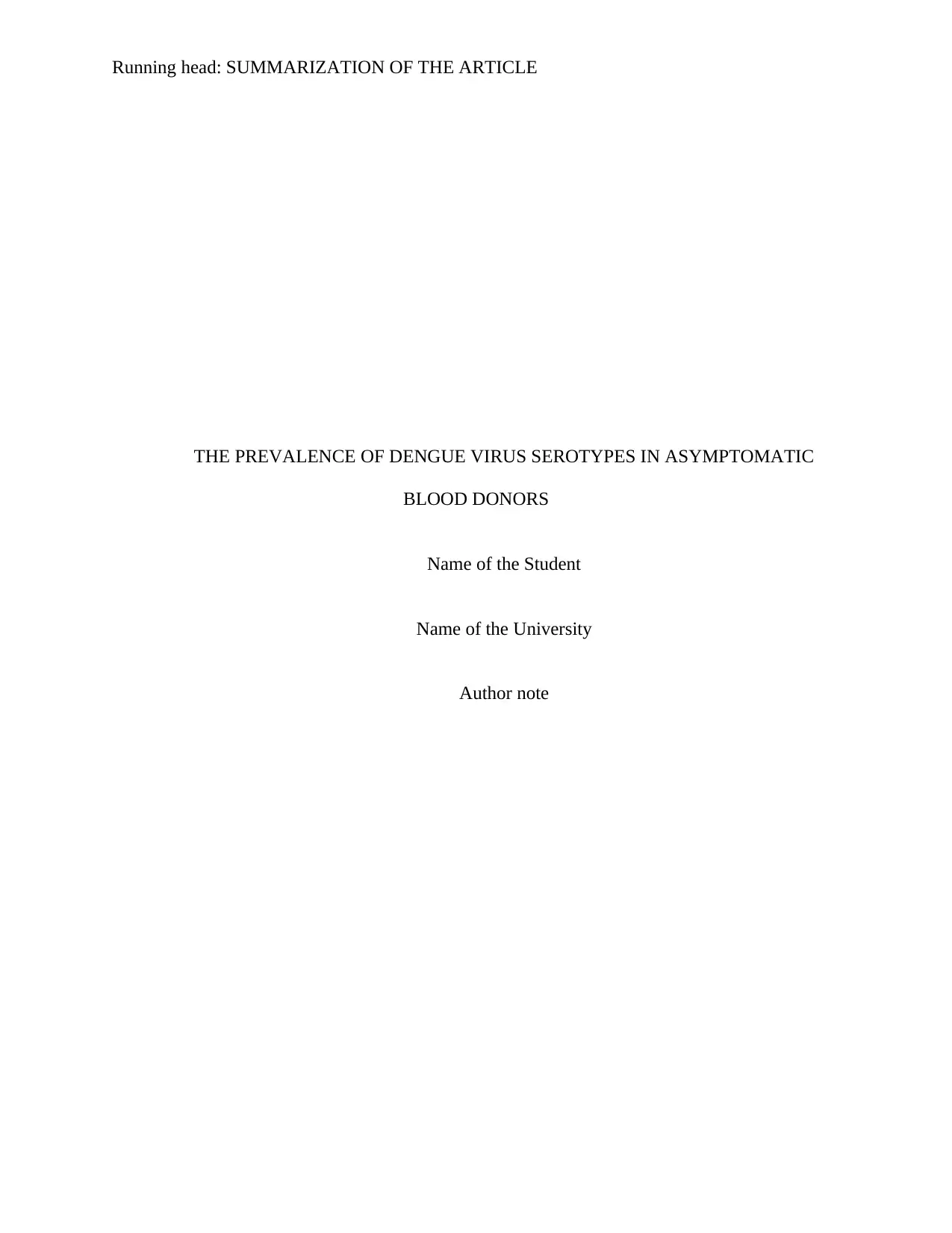
Running head: SUMMARIZATION OF THE ARTICLE
THE PREVALENCE OF DENGUE VIRUS SEROTYPES IN ASYMPTOMATIC
BLOOD DONORS
Name of the Student
Name of the University
Author note
THE PREVALENCE OF DENGUE VIRUS SEROTYPES IN ASYMPTOMATIC
BLOOD DONORS
Name of the Student
Name of the University
Author note
Secure Best Marks with AI Grader
Need help grading? Try our AI Grader for instant feedback on your assignments.
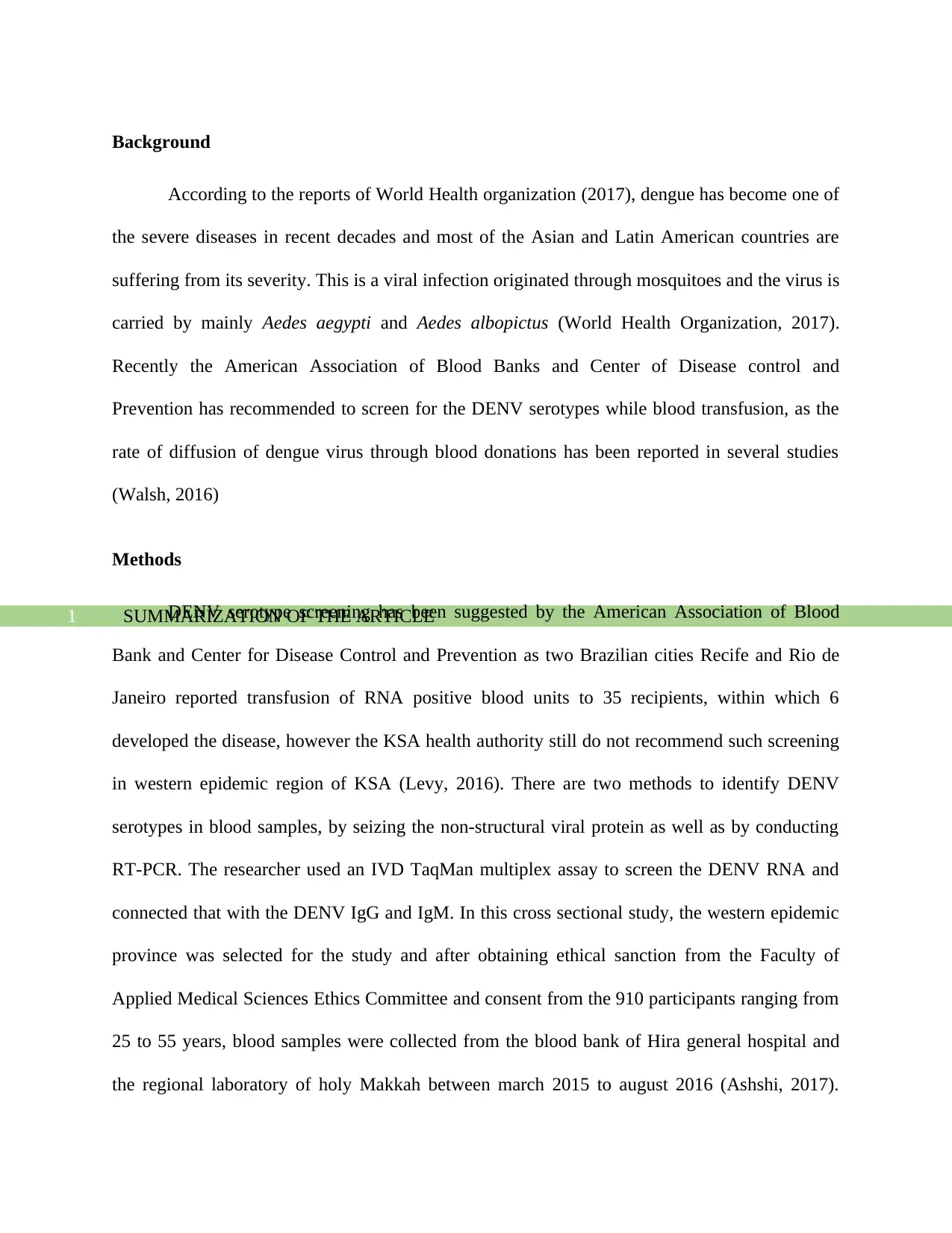
SUMMARIZATION OF THE ARTICLE1
Background
According to the reports of World Health organization (2017), dengue has become one of
the severe diseases in recent decades and most of the Asian and Latin American countries are
suffering from its severity. This is a viral infection originated through mosquitoes and the virus is
carried by mainly Aedes aegypti and Aedes albopictus (World Health Organization, 2017).
Recently the American Association of Blood Banks and Center of Disease control and
Prevention has recommended to screen for the DENV serotypes while blood transfusion, as the
rate of diffusion of dengue virus through blood donations has been reported in several studies
(Walsh, 2016)
Methods
DENV serotype screening has been suggested by the American Association of Blood
Bank and Center for Disease Control and Prevention as two Brazilian cities Recife and Rio de
Janeiro reported transfusion of RNA positive blood units to 35 recipients, within which 6
developed the disease, however the KSA health authority still do not recommend such screening
in western epidemic region of KSA (Levy, 2016). There are two methods to identify DENV
serotypes in blood samples, by seizing the non-structural viral protein as well as by conducting
RT-PCR. The researcher used an IVD TaqMan multiplex assay to screen the DENV RNA and
connected that with the DENV IgG and IgM. In this cross sectional study, the western epidemic
province was selected for the study and after obtaining ethical sanction from the Faculty of
Applied Medical Sciences Ethics Committee and consent from the 910 participants ranging from
25 to 55 years, blood samples were collected from the blood bank of Hira general hospital and
the regional laboratory of holy Makkah between march 2015 to august 2016 (Ashshi, 2017).
Background
According to the reports of World Health organization (2017), dengue has become one of
the severe diseases in recent decades and most of the Asian and Latin American countries are
suffering from its severity. This is a viral infection originated through mosquitoes and the virus is
carried by mainly Aedes aegypti and Aedes albopictus (World Health Organization, 2017).
Recently the American Association of Blood Banks and Center of Disease control and
Prevention has recommended to screen for the DENV serotypes while blood transfusion, as the
rate of diffusion of dengue virus through blood donations has been reported in several studies
(Walsh, 2016)
Methods
DENV serotype screening has been suggested by the American Association of Blood
Bank and Center for Disease Control and Prevention as two Brazilian cities Recife and Rio de
Janeiro reported transfusion of RNA positive blood units to 35 recipients, within which 6
developed the disease, however the KSA health authority still do not recommend such screening
in western epidemic region of KSA (Levy, 2016). There are two methods to identify DENV
serotypes in blood samples, by seizing the non-structural viral protein as well as by conducting
RT-PCR. The researcher used an IVD TaqMan multiplex assay to screen the DENV RNA and
connected that with the DENV IgG and IgM. In this cross sectional study, the western epidemic
province was selected for the study and after obtaining ethical sanction from the Faculty of
Applied Medical Sciences Ethics Committee and consent from the 910 participants ranging from
25 to 55 years, blood samples were collected from the blood bank of Hira general hospital and
the regional laboratory of holy Makkah between march 2015 to august 2016 (Ashshi, 2017).
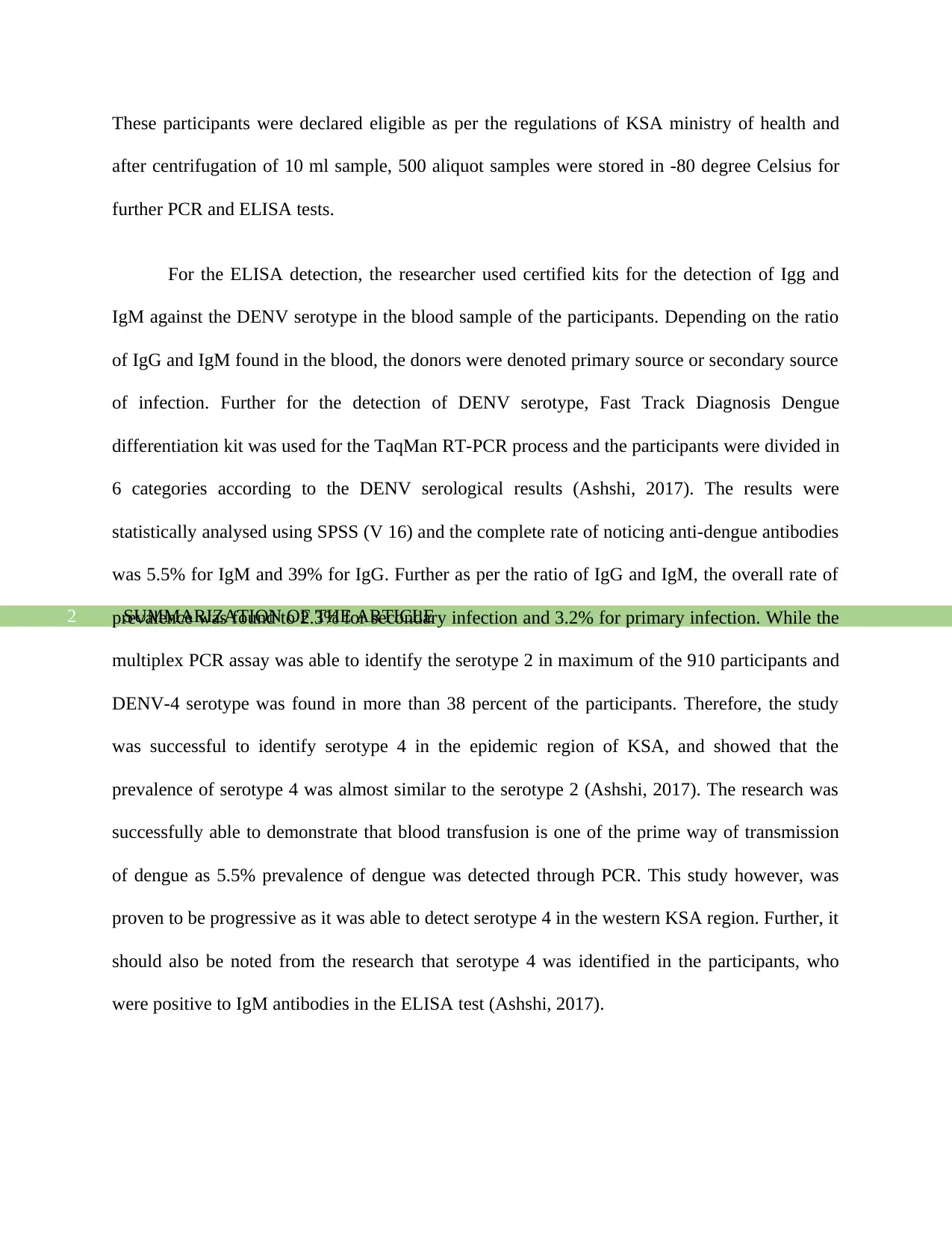
SUMMARIZATION OF THE ARTICLE2
These participants were declared eligible as per the regulations of KSA ministry of health and
after centrifugation of 10 ml sample, 500 aliquot samples were stored in -80 degree Celsius for
further PCR and ELISA tests.
For the ELISA detection, the researcher used certified kits for the detection of Igg and
IgM against the DENV serotype in the blood sample of the participants. Depending on the ratio
of IgG and IgM found in the blood, the donors were denoted primary source or secondary source
of infection. Further for the detection of DENV serotype, Fast Track Diagnosis Dengue
differentiation kit was used for the TaqMan RT-PCR process and the participants were divided in
6 categories according to the DENV serological results (Ashshi, 2017). The results were
statistically analysed using SPSS (V 16) and the complete rate of noticing anti-dengue antibodies
was 5.5% for IgM and 39% for IgG. Further as per the ratio of IgG and IgM, the overall rate of
prevalence was found to 2.3% for secondary infection and 3.2% for primary infection. While the
multiplex PCR assay was able to identify the serotype 2 in maximum of the 910 participants and
DENV-4 serotype was found in more than 38 percent of the participants. Therefore, the study
was successful to identify serotype 4 in the epidemic region of KSA, and showed that the
prevalence of serotype 4 was almost similar to the serotype 2 (Ashshi, 2017). The research was
successfully able to demonstrate that blood transfusion is one of the prime way of transmission
of dengue as 5.5% prevalence of dengue was detected through PCR. This study however, was
proven to be progressive as it was able to detect serotype 4 in the western KSA region. Further, it
should also be noted from the research that serotype 4 was identified in the participants, who
were positive to IgM antibodies in the ELISA test (Ashshi, 2017).
These participants were declared eligible as per the regulations of KSA ministry of health and
after centrifugation of 10 ml sample, 500 aliquot samples were stored in -80 degree Celsius for
further PCR and ELISA tests.
For the ELISA detection, the researcher used certified kits for the detection of Igg and
IgM against the DENV serotype in the blood sample of the participants. Depending on the ratio
of IgG and IgM found in the blood, the donors were denoted primary source or secondary source
of infection. Further for the detection of DENV serotype, Fast Track Diagnosis Dengue
differentiation kit was used for the TaqMan RT-PCR process and the participants were divided in
6 categories according to the DENV serological results (Ashshi, 2017). The results were
statistically analysed using SPSS (V 16) and the complete rate of noticing anti-dengue antibodies
was 5.5% for IgM and 39% for IgG. Further as per the ratio of IgG and IgM, the overall rate of
prevalence was found to 2.3% for secondary infection and 3.2% for primary infection. While the
multiplex PCR assay was able to identify the serotype 2 in maximum of the 910 participants and
DENV-4 serotype was found in more than 38 percent of the participants. Therefore, the study
was successful to identify serotype 4 in the epidemic region of KSA, and showed that the
prevalence of serotype 4 was almost similar to the serotype 2 (Ashshi, 2017). The research was
successfully able to demonstrate that blood transfusion is one of the prime way of transmission
of dengue as 5.5% prevalence of dengue was detected through PCR. This study however, was
proven to be progressive as it was able to detect serotype 4 in the western KSA region. Further, it
should also be noted from the research that serotype 4 was identified in the participants, who
were positive to IgM antibodies in the ELISA test (Ashshi, 2017).
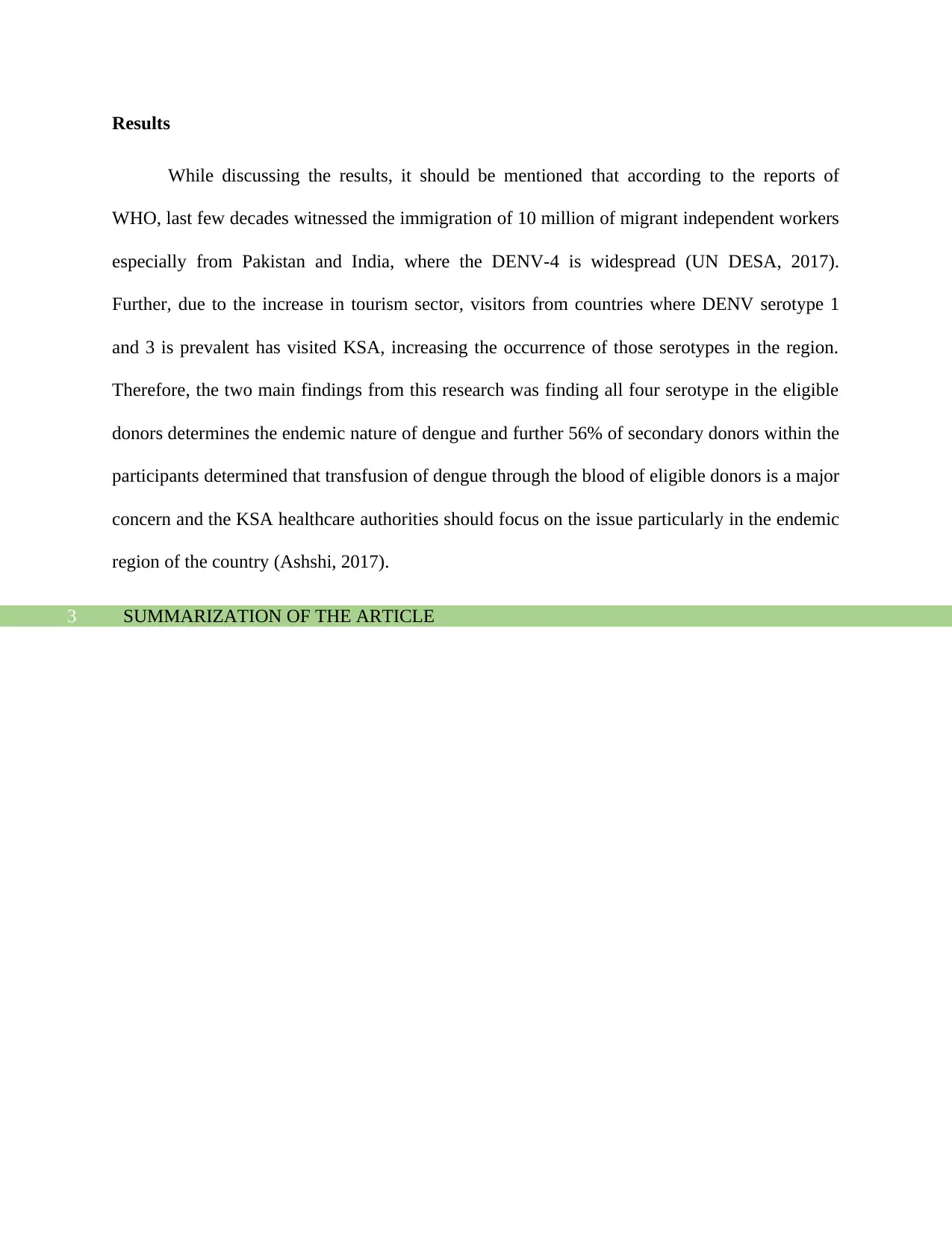
SUMMARIZATION OF THE ARTICLE3
Results
While discussing the results, it should be mentioned that according to the reports of
WHO, last few decades witnessed the immigration of 10 million of migrant independent workers
especially from Pakistan and India, where the DENV-4 is widespread (UN DESA, 2017).
Further, due to the increase in tourism sector, visitors from countries where DENV serotype 1
and 3 is prevalent has visited KSA, increasing the occurrence of those serotypes in the region.
Therefore, the two main findings from this research was finding all four serotype in the eligible
donors determines the endemic nature of dengue and further 56% of secondary donors within the
participants determined that transfusion of dengue through the blood of eligible donors is a major
concern and the KSA healthcare authorities should focus on the issue particularly in the endemic
region of the country (Ashshi, 2017).
Results
While discussing the results, it should be mentioned that according to the reports of
WHO, last few decades witnessed the immigration of 10 million of migrant independent workers
especially from Pakistan and India, where the DENV-4 is widespread (UN DESA, 2017).
Further, due to the increase in tourism sector, visitors from countries where DENV serotype 1
and 3 is prevalent has visited KSA, increasing the occurrence of those serotypes in the region.
Therefore, the two main findings from this research was finding all four serotype in the eligible
donors determines the endemic nature of dengue and further 56% of secondary donors within the
participants determined that transfusion of dengue through the blood of eligible donors is a major
concern and the KSA healthcare authorities should focus on the issue particularly in the endemic
region of the country (Ashshi, 2017).
Secure Best Marks with AI Grader
Need help grading? Try our AI Grader for instant feedback on your assignments.
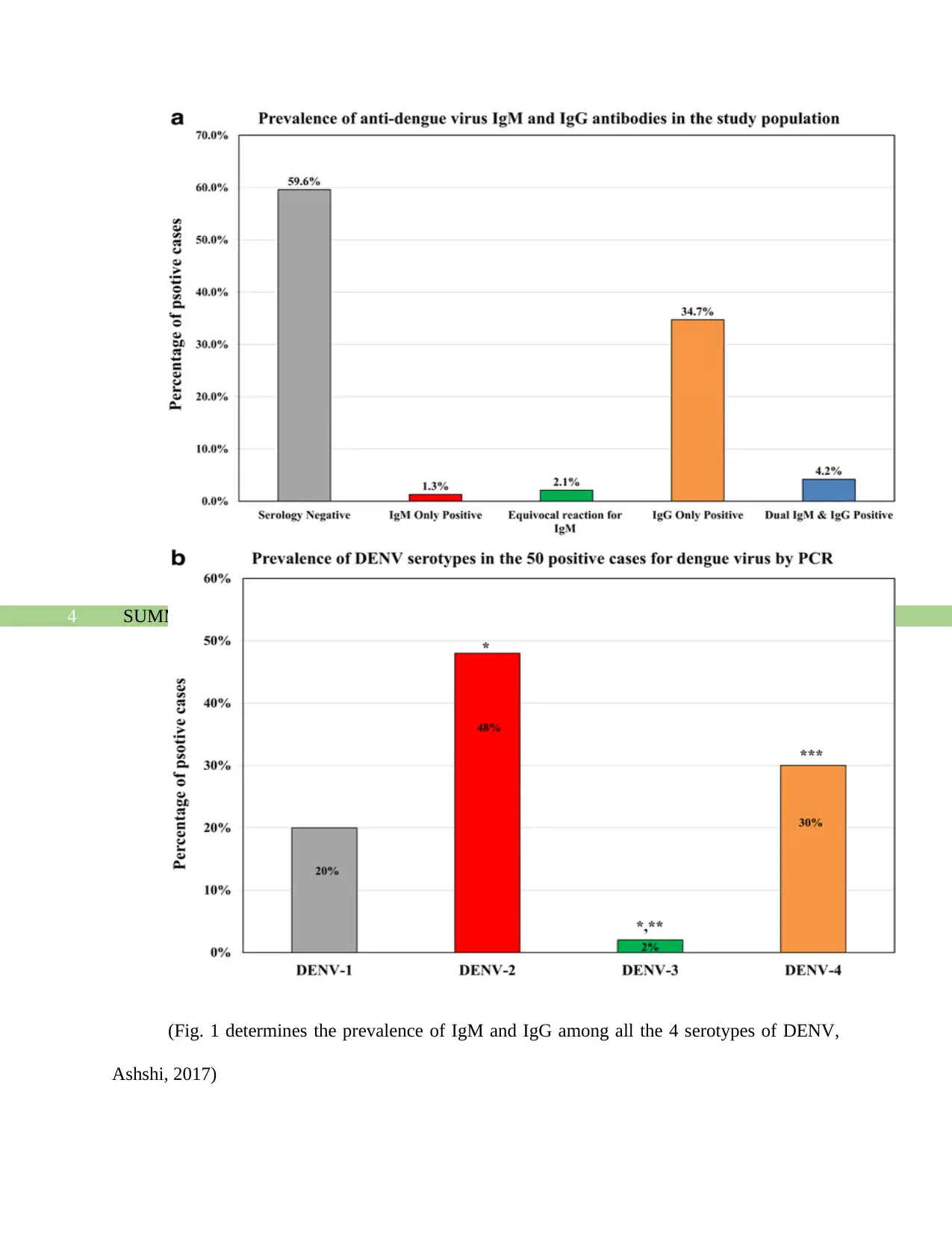
SUMMARIZATION OF THE ARTICLE4
(Fig. 1 determines the prevalence of IgM and IgG among all the 4 serotypes of DENV,
Ashshi, 2017)
(Fig. 1 determines the prevalence of IgM and IgG among all the 4 serotypes of DENV,
Ashshi, 2017)
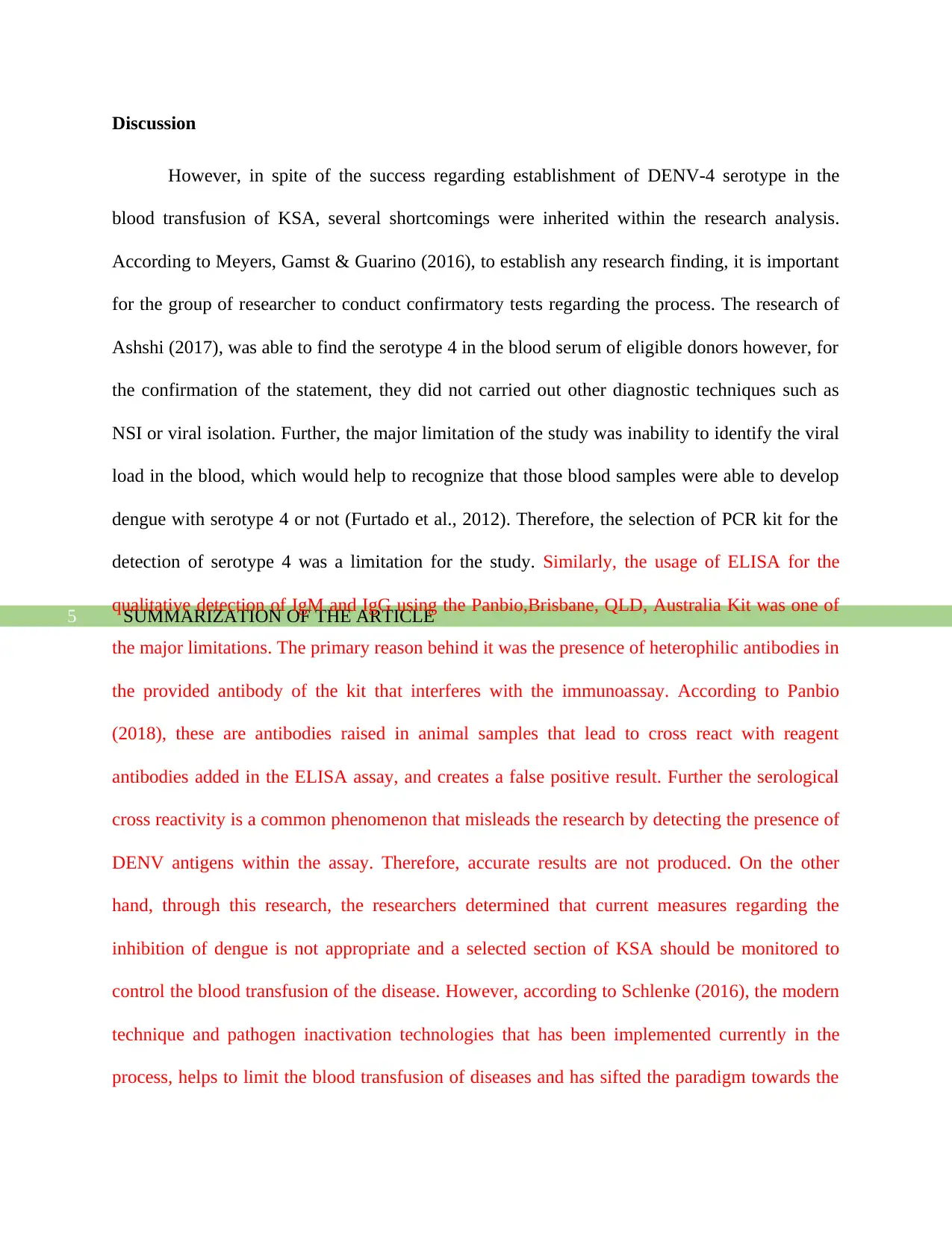
SUMMARIZATION OF THE ARTICLE5
Discussion
However, in spite of the success regarding establishment of DENV-4 serotype in the
blood transfusion of KSA, several shortcomings were inherited within the research analysis.
According to Meyers, Gamst & Guarino (2016), to establish any research finding, it is important
for the group of researcher to conduct confirmatory tests regarding the process. The research of
Ashshi (2017), was able to find the serotype 4 in the blood serum of eligible donors however, for
the confirmation of the statement, they did not carried out other diagnostic techniques such as
NSI or viral isolation. Further, the major limitation of the study was inability to identify the viral
load in the blood, which would help to recognize that those blood samples were able to develop
dengue with serotype 4 or not (Furtado et al., 2012). Therefore, the selection of PCR kit for the
detection of serotype 4 was a limitation for the study. Similarly, the usage of ELISA for the
qualitative detection of IgM and IgG using the Panbio,Brisbane, QLD, Australia Kit was one of
the major limitations. The primary reason behind it was the presence of heterophilic antibodies in
the provided antibody of the kit that interferes with the immunoassay. According to Panbio
(2018), these are antibodies raised in animal samples that lead to cross react with reagent
antibodies added in the ELISA assay, and creates a false positive result. Further the serological
cross reactivity is a common phenomenon that misleads the research by detecting the presence of
DENV antigens within the assay. Therefore, accurate results are not produced. On the other
hand, through this research, the researchers determined that current measures regarding the
inhibition of dengue is not appropriate and a selected section of KSA should be monitored to
control the blood transfusion of the disease. However, according to Schlenke (2016), the modern
technique and pathogen inactivation technologies that has been implemented currently in the
process, helps to limit the blood transfusion of diseases and has sifted the paradigm towards the
Discussion
However, in spite of the success regarding establishment of DENV-4 serotype in the
blood transfusion of KSA, several shortcomings were inherited within the research analysis.
According to Meyers, Gamst & Guarino (2016), to establish any research finding, it is important
for the group of researcher to conduct confirmatory tests regarding the process. The research of
Ashshi (2017), was able to find the serotype 4 in the blood serum of eligible donors however, for
the confirmation of the statement, they did not carried out other diagnostic techniques such as
NSI or viral isolation. Further, the major limitation of the study was inability to identify the viral
load in the blood, which would help to recognize that those blood samples were able to develop
dengue with serotype 4 or not (Furtado et al., 2012). Therefore, the selection of PCR kit for the
detection of serotype 4 was a limitation for the study. Similarly, the usage of ELISA for the
qualitative detection of IgM and IgG using the Panbio,Brisbane, QLD, Australia Kit was one of
the major limitations. The primary reason behind it was the presence of heterophilic antibodies in
the provided antibody of the kit that interferes with the immunoassay. According to Panbio
(2018), these are antibodies raised in animal samples that lead to cross react with reagent
antibodies added in the ELISA assay, and creates a false positive result. Further the serological
cross reactivity is a common phenomenon that misleads the research by detecting the presence of
DENV antigens within the assay. Therefore, accurate results are not produced. On the other
hand, through this research, the researchers determined that current measures regarding the
inhibition of dengue is not appropriate and a selected section of KSA should be monitored to
control the blood transfusion of the disease. However, according to Schlenke (2016), the modern
technique and pathogen inactivation technologies that has been implemented currently in the
process, helps to limit the blood transfusion of diseases and has sifted the paradigm towards the
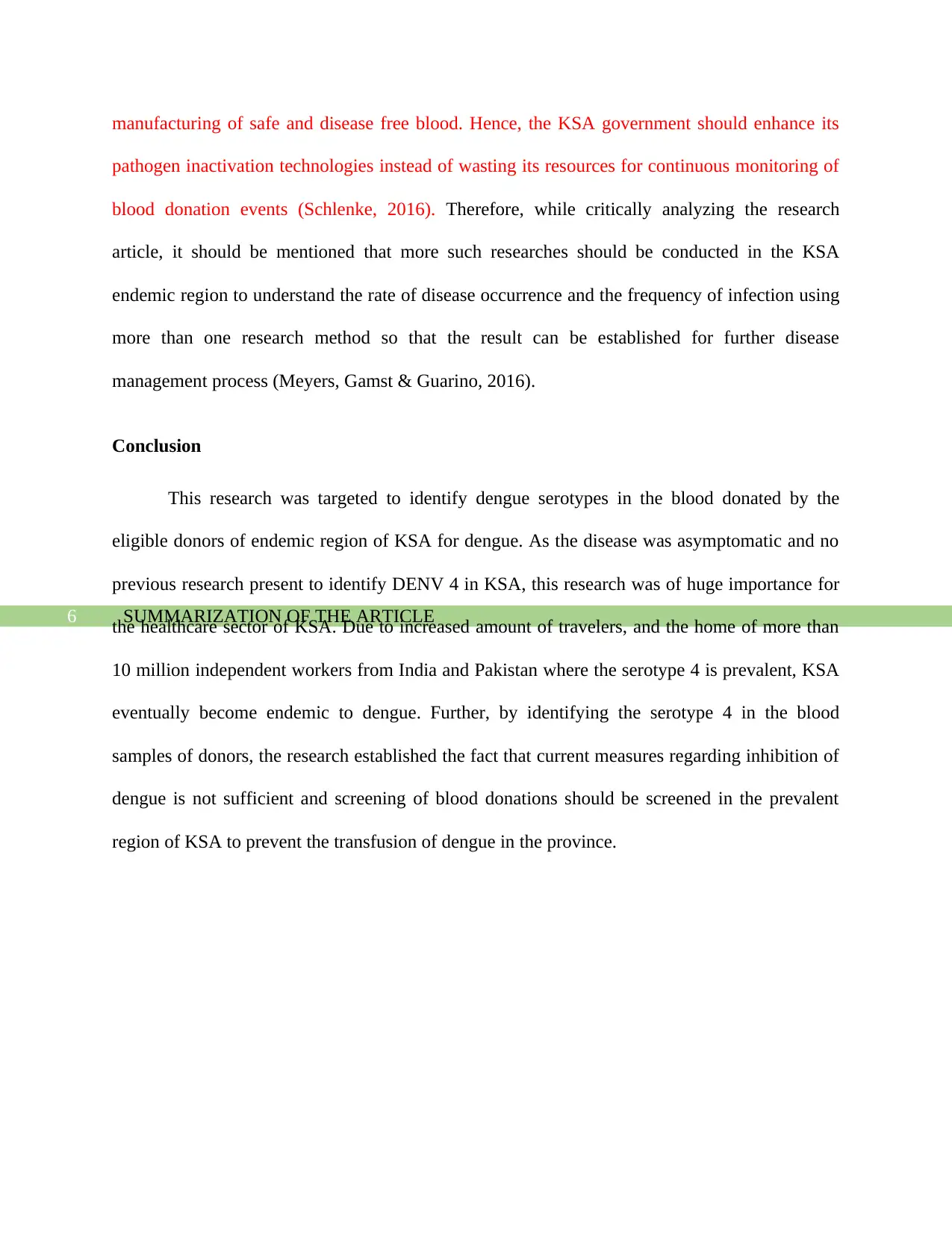
SUMMARIZATION OF THE ARTICLE6
manufacturing of safe and disease free blood. Hence, the KSA government should enhance its
pathogen inactivation technologies instead of wasting its resources for continuous monitoring of
blood donation events (Schlenke, 2016). Therefore, while critically analyzing the research
article, it should be mentioned that more such researches should be conducted in the KSA
endemic region to understand the rate of disease occurrence and the frequency of infection using
more than one research method so that the result can be established for further disease
management process (Meyers, Gamst & Guarino, 2016).
Conclusion
This research was targeted to identify dengue serotypes in the blood donated by the
eligible donors of endemic region of KSA for dengue. As the disease was asymptomatic and no
previous research present to identify DENV 4 in KSA, this research was of huge importance for
the healthcare sector of KSA. Due to increased amount of travelers, and the home of more than
10 million independent workers from India and Pakistan where the serotype 4 is prevalent, KSA
eventually become endemic to dengue. Further, by identifying the serotype 4 in the blood
samples of donors, the research established the fact that current measures regarding inhibition of
dengue is not sufficient and screening of blood donations should be screened in the prevalent
region of KSA to prevent the transfusion of dengue in the province.
manufacturing of safe and disease free blood. Hence, the KSA government should enhance its
pathogen inactivation technologies instead of wasting its resources for continuous monitoring of
blood donation events (Schlenke, 2016). Therefore, while critically analyzing the research
article, it should be mentioned that more such researches should be conducted in the KSA
endemic region to understand the rate of disease occurrence and the frequency of infection using
more than one research method so that the result can be established for further disease
management process (Meyers, Gamst & Guarino, 2016).
Conclusion
This research was targeted to identify dengue serotypes in the blood donated by the
eligible donors of endemic region of KSA for dengue. As the disease was asymptomatic and no
previous research present to identify DENV 4 in KSA, this research was of huge importance for
the healthcare sector of KSA. Due to increased amount of travelers, and the home of more than
10 million independent workers from India and Pakistan where the serotype 4 is prevalent, KSA
eventually become endemic to dengue. Further, by identifying the serotype 4 in the blood
samples of donors, the research established the fact that current measures regarding inhibition of
dengue is not sufficient and screening of blood donations should be screened in the prevalent
region of KSA to prevent the transfusion of dengue in the province.
Paraphrase This Document
Need a fresh take? Get an instant paraphrase of this document with our AI Paraphraser
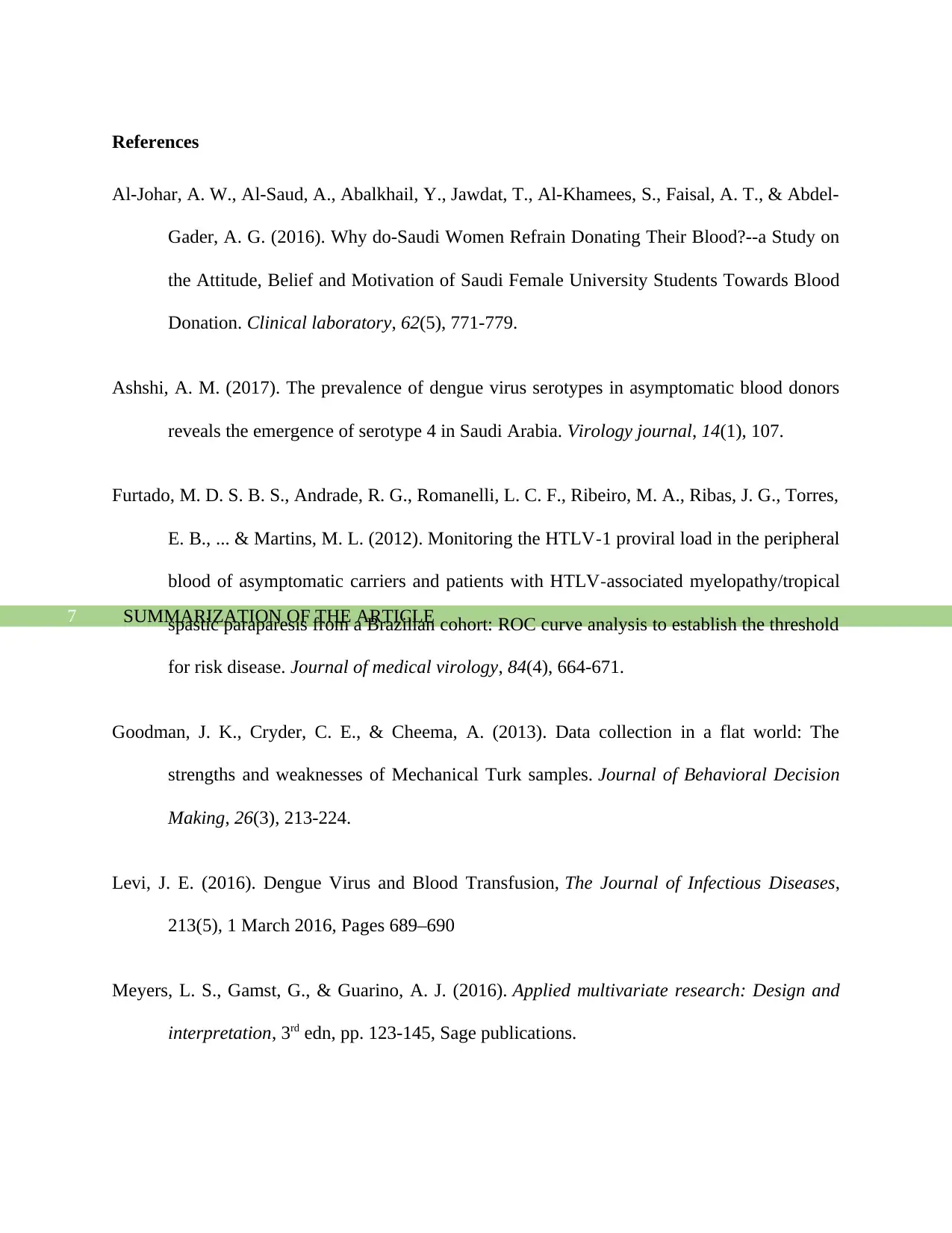
SUMMARIZATION OF THE ARTICLE7
References
Al-Johar, A. W., Al-Saud, A., Abalkhail, Y., Jawdat, T., Al-Khamees, S., Faisal, A. T., & Abdel-
Gader, A. G. (2016). Why do-Saudi Women Refrain Donating Their Blood?--a Study on
the Attitude, Belief and Motivation of Saudi Female University Students Towards Blood
Donation. Clinical laboratory, 62(5), 771-779.
Ashshi, A. M. (2017). The prevalence of dengue virus serotypes in asymptomatic blood donors
reveals the emergence of serotype 4 in Saudi Arabia. Virology journal, 14(1), 107.
Furtado, M. D. S. B. S., Andrade, R. G., Romanelli, L. C. F., Ribeiro, M. A., Ribas, J. G., Torres,
E. B., ... & Martins, M. L. (2012). Monitoring the HTLV‐1 proviral load in the peripheral
blood of asymptomatic carriers and patients with HTLV‐associated myelopathy/tropical
spastic paraparesis from a Brazilian cohort: ROC curve analysis to establish the threshold
for risk disease. Journal of medical virology, 84(4), 664-671.
Goodman, J. K., Cryder, C. E., & Cheema, A. (2013). Data collection in a flat world: The
strengths and weaknesses of Mechanical Turk samples. Journal of Behavioral Decision
Making, 26(3), 213-224.
Levi, J. E. (2016). Dengue Virus and Blood Transfusion, The Journal of Infectious Diseases,
213(5), 1 March 2016, Pages 689–690
Meyers, L. S., Gamst, G., & Guarino, A. J. (2016). Applied multivariate research: Design and
interpretation, 3rd edn, pp. 123-145, Sage publications.
References
Al-Johar, A. W., Al-Saud, A., Abalkhail, Y., Jawdat, T., Al-Khamees, S., Faisal, A. T., & Abdel-
Gader, A. G. (2016). Why do-Saudi Women Refrain Donating Their Blood?--a Study on
the Attitude, Belief and Motivation of Saudi Female University Students Towards Blood
Donation. Clinical laboratory, 62(5), 771-779.
Ashshi, A. M. (2017). The prevalence of dengue virus serotypes in asymptomatic blood donors
reveals the emergence of serotype 4 in Saudi Arabia. Virology journal, 14(1), 107.
Furtado, M. D. S. B. S., Andrade, R. G., Romanelli, L. C. F., Ribeiro, M. A., Ribas, J. G., Torres,
E. B., ... & Martins, M. L. (2012). Monitoring the HTLV‐1 proviral load in the peripheral
blood of asymptomatic carriers and patients with HTLV‐associated myelopathy/tropical
spastic paraparesis from a Brazilian cohort: ROC curve analysis to establish the threshold
for risk disease. Journal of medical virology, 84(4), 664-671.
Goodman, J. K., Cryder, C. E., & Cheema, A. (2013). Data collection in a flat world: The
strengths and weaknesses of Mechanical Turk samples. Journal of Behavioral Decision
Making, 26(3), 213-224.
Levi, J. E. (2016). Dengue Virus and Blood Transfusion, The Journal of Infectious Diseases,
213(5), 1 March 2016, Pages 689–690
Meyers, L. S., Gamst, G., & Guarino, A. J. (2016). Applied multivariate research: Design and
interpretation, 3rd edn, pp. 123-145, Sage publications.
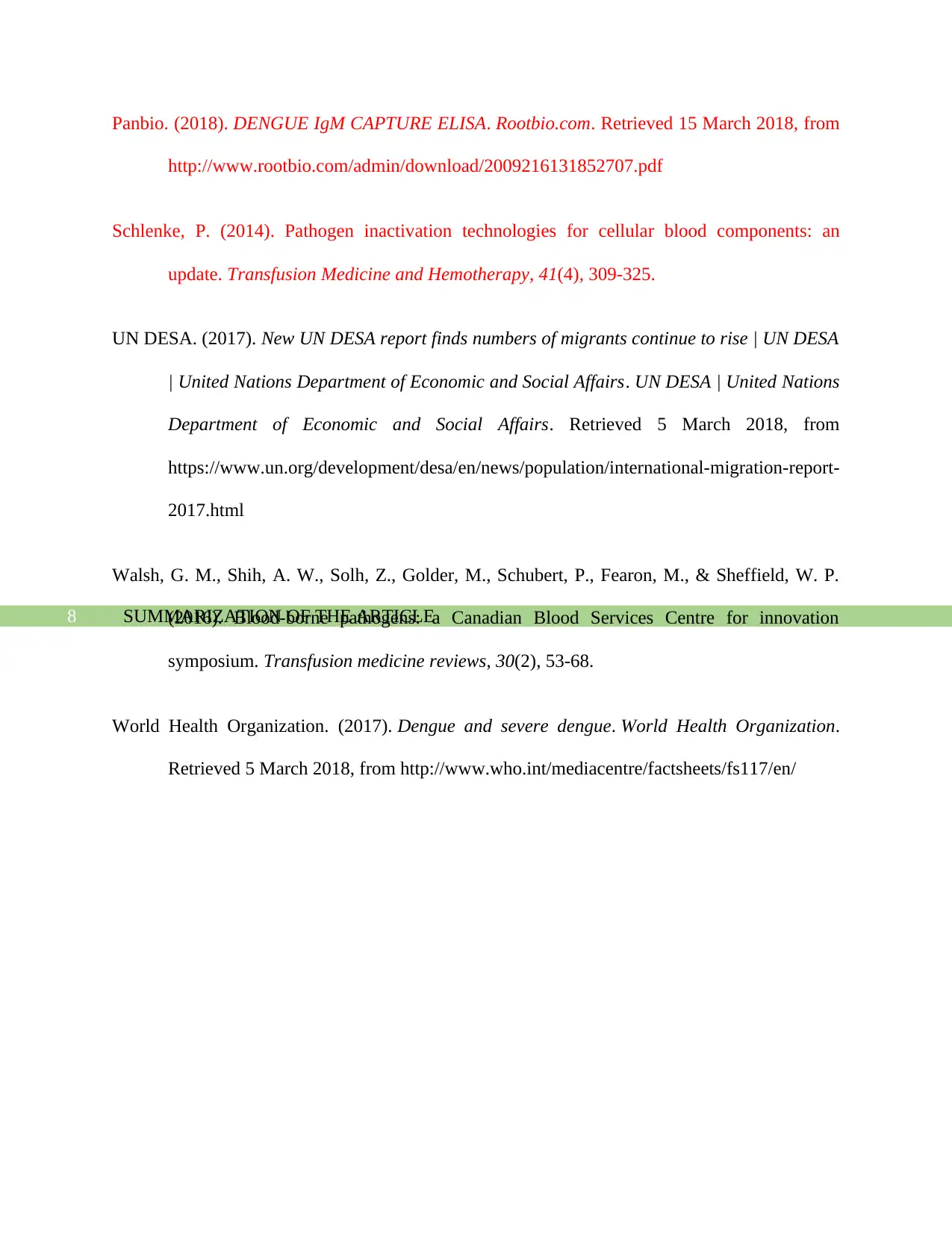
SUMMARIZATION OF THE ARTICLE8
Panbio. (2018). DENGUE IgM CAPTURE ELISA. Rootbio.com. Retrieved 15 March 2018, from
http://www.rootbio.com/admin/download/2009216131852707.pdf
Schlenke, P. (2014). Pathogen inactivation technologies for cellular blood components: an
update. Transfusion Medicine and Hemotherapy, 41(4), 309-325.
UN DESA. (2017). New UN DESA report finds numbers of migrants continue to rise | UN DESA
| United Nations Department of Economic and Social Affairs. UN DESA | United Nations
Department of Economic and Social Affairs. Retrieved 5 March 2018, from
https://www.un.org/development/desa/en/news/population/international-migration-report-
2017.html
Walsh, G. M., Shih, A. W., Solh, Z., Golder, M., Schubert, P., Fearon, M., & Sheffield, W. P.
(2016). Blood-borne pathogens: a Canadian Blood Services Centre for innovation
symposium. Transfusion medicine reviews, 30(2), 53-68.
World Health Organization. (2017). Dengue and severe dengue. World Health Organization.
Retrieved 5 March 2018, from http://www.who.int/mediacentre/factsheets/fs117/en/
Panbio. (2018). DENGUE IgM CAPTURE ELISA. Rootbio.com. Retrieved 15 March 2018, from
http://www.rootbio.com/admin/download/2009216131852707.pdf
Schlenke, P. (2014). Pathogen inactivation technologies for cellular blood components: an
update. Transfusion Medicine and Hemotherapy, 41(4), 309-325.
UN DESA. (2017). New UN DESA report finds numbers of migrants continue to rise | UN DESA
| United Nations Department of Economic and Social Affairs. UN DESA | United Nations
Department of Economic and Social Affairs. Retrieved 5 March 2018, from
https://www.un.org/development/desa/en/news/population/international-migration-report-
2017.html
Walsh, G. M., Shih, A. W., Solh, Z., Golder, M., Schubert, P., Fearon, M., & Sheffield, W. P.
(2016). Blood-borne pathogens: a Canadian Blood Services Centre for innovation
symposium. Transfusion medicine reviews, 30(2), 53-68.
World Health Organization. (2017). Dengue and severe dengue. World Health Organization.
Retrieved 5 March 2018, from http://www.who.int/mediacentre/factsheets/fs117/en/
1 out of 9
Your All-in-One AI-Powered Toolkit for Academic Success.
+13062052269
info@desklib.com
Available 24*7 on WhatsApp / Email
![[object Object]](/_next/static/media/star-bottom.7253800d.svg)
Unlock your academic potential
© 2024 | Zucol Services PVT LTD | All rights reserved.
